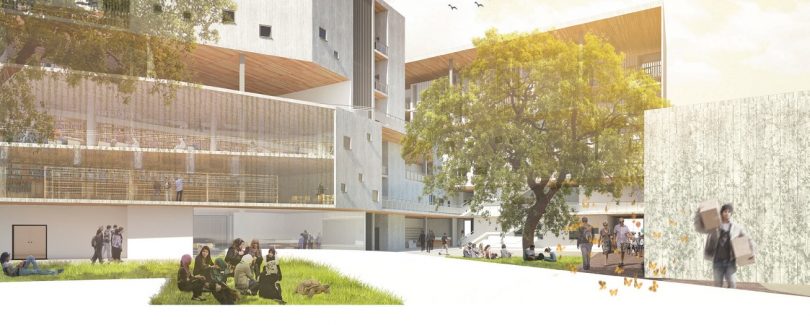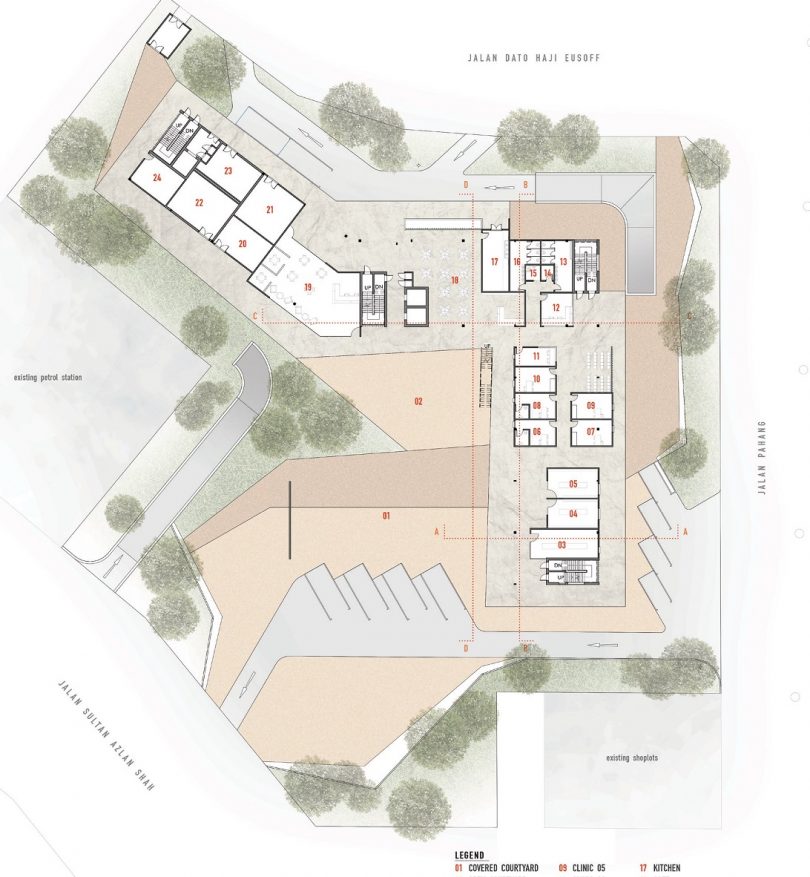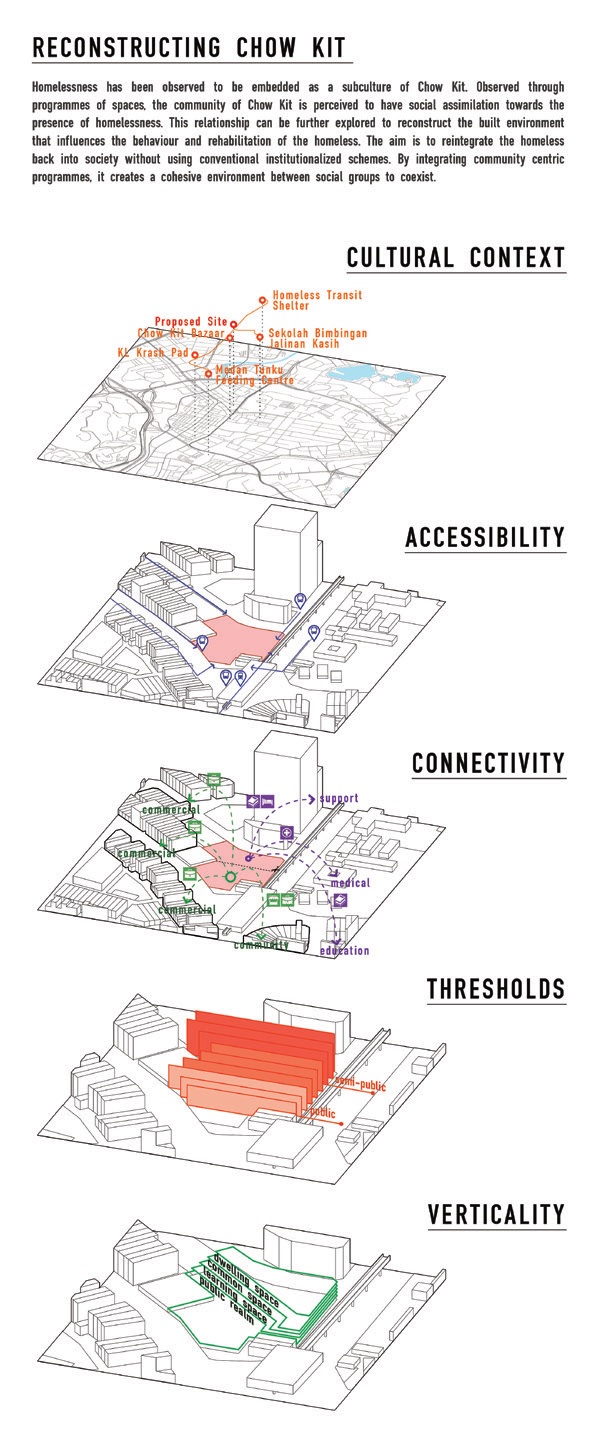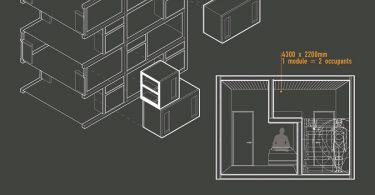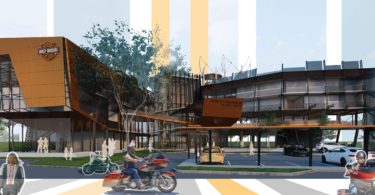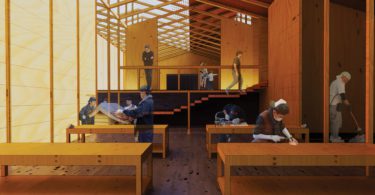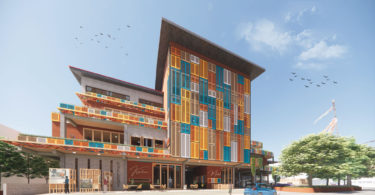Homeless shelters are known to be the immediate solution for the homeless throughout the world. Sheltering them off the streets is seemingly the best approach taken by most governmental bodies and social welfare institutions. However, this thesis by Kenneth Ooi challenges the utilitarian methodology of approaching homelessness.
Homelessness is not simply about an individual lacking a physical ‘home’, but usually involves psychological struggles, drug-abuse and financial issues. Hence, what is needed is more than accommodation; instead, a progressive and conducive environment where these individuals have access to support facilities provides a more holistic solution. Addressing the root of homelessness would play an important role in the reintegration of the homeless back into the community.
RECONSTRUCTING ENVIRONMENT
Chow Kit has been infamously known as the urban slum of Kuala Lumpur as the streets would be filled with the homeless and poor waiting for food distributions from local non-government organisations (NGOs) on alternate nights.
Hence, the selection of the site of the shelter is at the core of this area. By reconstructing the built environment in Chow Kit and integrating community-centric programmes, a cohesive environment is created to influence and rehabilitate the homeless.
The proposed site is easily accessible with good connectivity to relevant support, medical aid, and education centres. The front part of the seven-storey shelter is the public realm with open and covered courtyards—this serves as a neutral zone for the public and the homeless to intersect and interact. This is followed by the learning space, a common space with recreational activities and amenities, and finally, the dwelling space.
On the ground floor, there will be retail lots, clinics, a pharmacy, bathrooms, a kitchen and café, an NGO hub, and a recycling collection centre, among others. Space on the other levels is carved out for learning and development, support and training, and services and amenities, apart from sleeping areas. By introducing self-reliance development programmes, the homeless can discover their independence and dignity to become useful members of society.
BUILDING A HOME
The homeless population is very subjective as it fluctuates according to economic conditions, therefore, the flexibility of a shelter building is important to be able to inject some permanence into an accommodation for short-term residents.
The proposed solution is a form of modular dwelling, with provisions for enlarging or reducing space based on need. The modules are constructed with steel frame structures and prefabricated steel frame panels, a portal frame with integrated amenities such as LED lighting, screens for natural ventilation, and timber support.
Prefabrication of these modules will be a faster and more efficient method to erect this structure. While concrete or brickwork of a simple shelter may be cheaper, steel can be recycled, which translates into a longer life cycle for the building. The modules can also be transferred to another centre if no longer needed.
The common feedback on this design was that “it looks very expensive for a homeless centre”. Unfortunately, most homeless shelters do look cheap and simple, as they are usually poorly planned temporary structures to ‘accommodate’ the homeless until they get a job.
The social stigma towards the homeless lead to them being classified as the underclass of society, resulting in them being further isolated and neglected. The approach of this design, which may admittedly require more fine-tuning in terms of practicality, is to provide a plug-and-play system with flexible spaces of living and interaction to allow the homeless to have a sense of community and place during their rehabilitation.
SHAPED BY BUILDINGS
Architecture cannot resolve homelessness, but it can provide the appropriate remedies to facilitate their rehabilitation. The transitory process that the homeless undergoes requires a balanced environment between permanence and impermanence. Architecture can provide spaces that synergise with their recovery, without institutionalising their surroundings. Generic models of homeless shelters have failed to suit the need of having to accommodate individuals of diverse cultures and backgrounds.
This project explores the hospitability potentials of collective dwellings towards empowering the homeless, re-evaluating building typologies used to accommodate/rehabilitate the homeless, and giving due consideration to humanising the spatial aspects of the centre.
PROJECT DATA
Student Name: Kenneth Ooi Shiong Chien
School: School of Architecture, Building & Design, Taylor’s University Lakeside Campus
Programme: Master of Architecture
Supervisor/Instructor: Ar Edward Chew; Prof Robert Powell
Project Name: Architecture for the Homeless: Beyond Impermanence
Location: Chow Kit, Kuala Lumpur
Site Area: 6,981 square metres
Building Height: 7 storeys; 22 metres
Images: Kenneth Ooi Shiong Chien




